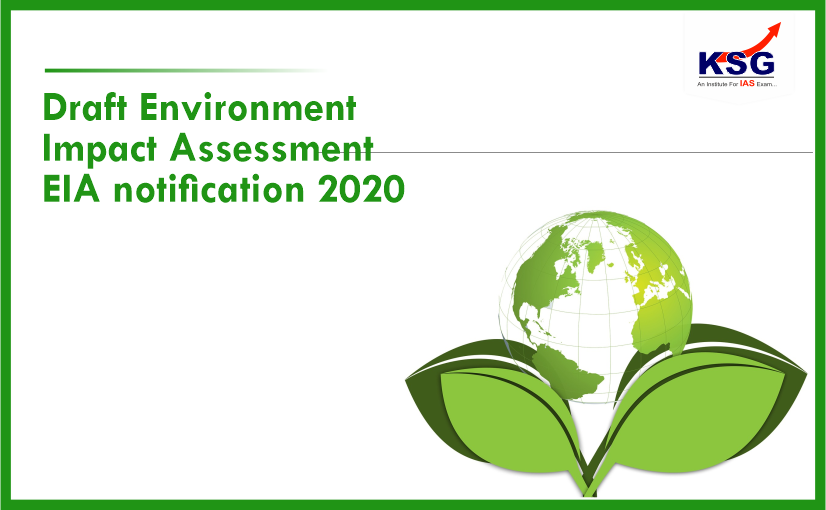Draft Environment Impact Assessment Notification 2020
What is Environmental Impact Assessment?
As per United Nations Environment Program (UNEP), Environmental Impact Assessment (EIA) is a tool used to identify the environmental, social, and economic impacts of a project prior to decision-making.

Draft Environment Impact Assessment Notification 2020
What is Environmental Impact Assessment?
As per United Nations Environment Program (UNEP), Environmental Impact Assessment (EIA) is a tool used to identify the environmental, social, and economic impacts of a project prior to decision-making.
The objective is to anticipate the environmental impact of a project design and planning, find out the alternative ways to reduce the impact, shift the burden from the local environment, and come up with accurate solutions for the decision-makers.
History of Environmental Impact Assessment
Environmental Impact Assessment Draft 2020 falls under the Environment Protection Act, 1986 which contains the provisions on the methodology and process. Under this Act, India notified its first EIA norms in 1994.
The proposed draft Environment Impact Assessment Notification, 2020 seeks to replace the current notification that dates back to 2006 under Environment Protection Act, 1986.
Importance of Environmental Impact Assessment
- It provides cost-effective methods to eliminate or minimize the effect of the project on the environment.
- Enable the decision-maker to analyze the developmental cost of a project on the environment.
- Make sure the developmental plan is environment-friendly.
Why is the new EIA Draft problematic?
a) Post clearance compliance
It means the industry can apply for Environment impact assessment after starting the operation or the process. This amounts to the legitimization of violations as any environmental damage caused by the project is likely to be waived off.
Post-facto approval is a clear violation of fundamental principles of environmental jurisprudence including the "precautionary principle".
b) Reduced time for Public Hearing
Every EIA is presented for the public hearing. Earlier the time period was 30 days which is reduced to 20 days in EIA Draft 2020. The reduction of time period questions the transparency and democracy in India.
c) Exemptions of project assessment
The project is categorized into Category A, B1, and B2. for B2 Project which is ‘strategic’ exempted from the assessment. Therefore, no information related to the project shall be placed in the public domain. All inland waterways and national highways, Offshore and onshore oil, gas and shale exploration, etc have been excluded from the public consultation. There is also a provision to exempt the construction projects up to 1,50,000 Sq.mts.
d) Annual Submission of report
The new EIA Draft 2020, requires the promoter to submit the report annually whereas, in the 2006 notification, the report had to be submitted every 6 months. The new proposal will give an opportunity to the industries to hide the disastrous consequences of the projects.
e) No public reporting for Non- Compliance
The EIA Draft 2020 has notified that the report will not be submitted by the public in case of non-compliance by the industries. The report can be submitted by only violator-promoter, government authority, Appraisal Committee, or Regulatory Authority.
Issues Associated with the New EIA Draft
a) Post facto clearance of the project has given a way to violate the laws by various industrial projects.
b) The draft has strengthened the government and made the public weak by shortening the public hearing.
c) Increasing the time period to submit the report will help the project to hide the disastrous consequences of their projects.
Consequences of dilution of EIA rules
a) Recent incidents such as the gas leak at the LG Polymers’ Visakhapatnam plant point out the importance of EIA in our country.
b) In Samarth Trust Case, the Delhi High Court has ruled that EIAs are an essential part of participatory justice which intends to give voice to the voiceless. Therefore, any dilution in the rules would go against the democratic norms.
c) Lack of trained EIA professionals might lead to irrelevant reports and this runs the risk of ignoring the indigenous knowledge.
There is a need to take strict actions against the new EIA Draft 2020 which can be proved a regressive departure from the earlier EIA 2006 and has the potential to reduce the effectiveness of the Environment Impact Assessment Study which can be detrimental to environmental protection.
EIA also needs to be accompanied by Social Impact Assessment to measure the impact holistically and follow “Grow now, and sustain later” to achieve sustainable development.
Environmental issues are best handled through the participation of all the concerned citizens. Hence, the government should ensure access to information and provide an opportunity for all the stakeholders to participate in the decision-making process.


